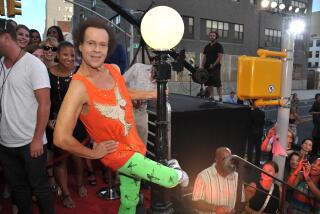Howard ‘Sandman’ Sims, 86; Tap Dancer Famed for His Percussive Range
Howard “Sandman” Sims, a distinctive and influential tap dancer who gained his nickname from dancing on the sand he sprinkled on a tap board or across the stage floor, has died. He was 86.
Famed for the range of percussive sounds that his sand-dancing could produce -- from the sweetest brushing to the most abrasive grinding -- Sims died May 20 in New York City’s Bronx.
Although he had tap-danced since the age of 3, he discovered his style accidentally while training to be a boxer and shuffling his feet in a rosin box, he told The Times in a 1986 interview. The result earned him widespread acclaim, and even sustained him during the decline of tap in the 1950s and ‘60s.
“They called the board my Stradivarius,” Sims liked to say. “I could use any kind of music -- or I could do it without any music at all.”
He was born on Jan. 24, 1917 -- in Los Angeles, according to some sources, though others say Fort Smith, Ark. One of 10 children, he began dancing with his brothers on L.A. street corners. After breaking his hand twice, he gave up boxing and danced in Latin America before heading to New York City after World War II.
“If I saw a dancer, I’d challenge him,” Sims remembered in a 1989 Associated Press interview. “I didn’t care who it was. The way to get known in New York was to be the best. That’s what I strived to be. It has kept me going.”
Dance historian Sally R. Sommer has described Sims’ tap style as strong and vigorous: “body hunkered over, knees bent, feet digging into the floor -- and his sand dance was characterized by clear, quick rhythms and subtle nuances.”
The purity of this style and in particular its insistence on using the feet as a musical instrument, greatly influenced such recent tap stars as Gregory Hines and Savion Glover.
“The feet are a set of drums,” Sims said in the 1979 film documentary “No Maps on My Taps.” “The heels are the bass, the toes the melody, and you get off rim shots with the sides of the foot.”
His unusual attitude as a performer also made its mark, rejecting audience-courting smiles in favor of a kind of curt self-assertion.
“This is for you,” he’d tell the audience when executing an especially flashy step. “And now this is for me.”
He needed that self-assertion for more than sand-dancing because starting in the 1950s he worked at the famed Apollo Theatre in Harlem as “the executioner,” the man who yanked unpopular or downright awful performers off the stage on amateur nights. “Sometimes,” he said in a 1987 New York Times interview, “performers wait outside to beat me up.”
He also worked as the Apollo’s stage manager and supported himself as a carpenter, mechanic and tap teacher. His students included such stellar dancers as Hines and Ben Vereen, but also boxers Sugar Ray Robinson and Muhammad Ali, who came to him to improve their footwork.
In 1984, Sims won a National Heritage Fellowship from the National Endowment for the Arts and used the money to teach dance to children in a Harlem parking lot. Two years later, he appeared in “The Sand Dancer,” a play by poet Sandra Hochman inspired by his life and career. In 1989, he was widely seen in the film “Tap” and the PBS “Dance in America” special, “Tap Dance in America,” both starring Hines. He also toured widely in the 1980s, dancing in 53 countries for the U.S. State Department.
Because he danced with his whole foot, not just the heel and toe, Sims called himself a hoofer, rather than a tapper. And he considered rhythm a physical force to be reckoned with.
“I was on the subway once and I had to get off,” he said in a 1963 interview, “because that simple rhythm of the wheels was interfering with the rhythms I happened to be feeling.”
“It’s supposed to be easy and simple and beautiful,” he told the Washington Post in 1980. “All you need is your shoes and a floor and smart feet.”
Sims is survived by his wife, Solange; two daughters; one son; nine grandchildren; and a dozen great-grandchildren.
More to Read
The biggest entertainment stories
Get our big stories about Hollywood, film, television, music, arts, culture and more right in your inbox as soon as they publish.
You may occasionally receive promotional content from the Los Angeles Times.










